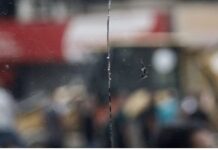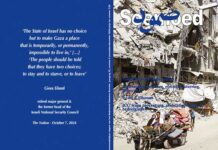Bethan McKernan
The Guardian / September 10, 2024
At least 19 people killed as missiles hit overcrowded area in attack that Israel says targeted a Hamas command centre.
Israeli airstrikes on Al-Mawasi “humanitarian zone” in the Gaza Strip have killed at least 19 people and injured a further 60, according to witnesses and medical officials in the blockaded Palestinian territory.
At least four missiles hit the overcrowded supposed “safe zone” on the coast in the early hours of Tuesday, causing dozens of tents to catch fire and leaving craters as deep as 9 metres, the civil emergency service said. Hundreds of thousands of displaced people are sheltering in Al-Mawasi, where conditions are dire, after being ordered to move there by the Israeli military.
“Entire families disappeared in the Mawasi Khan Younis massacre, under the sand, in deep holes,” the Gaza civil defence spokesperson Mahmoud Bassal told Agence France-Presse.
Dr Elspeth Pitt, a Scottish emergency doctor working at a field hospital in Al-Mawasi run by the British medical humanitarian organization UK-Med, said the clinic was shaken by large explosions shortly after midnight.
“We received 26 patients, mostly women and children. We had to do several amputations and dealt with shrapnel injuries and burns. The conditions are very challenging … there are supply chain issues all the time. At the moment we have a shortage of gauze. We are improvising and doing what we can,” she said.
First responders had initially put the number of dead at 40, before the health ministry in the Hamas-run territory released updated figures, while warning the toll was likely to rise. The Israeli military disputed the earlier casualty figure.
The Israel Defense Forces (IDF) said they had “struck significant Hamas terrorists who were operating within a command and control centre embedded inside the humanitarian area in Khan Younis”.
Among the targets were two men they said were involved in Hamas’s 7 October attack on Israel that triggered the war: Samer Abu Daqqa, the head of Hamas’s aerial unit, and Osama Tabesh, the head of the observation and targets department in Hamas’s intelligence unit.
“The terrorists advanced and carried out terror attacks against IDF troops and the state of Israel,” they said. Hamas has denied that any fighters or commanders were present in the area.
Later on Tuesday morning, rescue workers and residents were still trying to find missing people and evacuate the wounded, sifting through the sand with garden tools and their bare hands, finding many body parts. Ambulances raced back and forth, while Israeli jets could still be heard overhead.
“We were sleeping and suddenly it was like a tornado,” Samar Moamer told the Associated Press at Nasser hospital in Khan Younis, where she was being treated for injuries from the strike. She said one of her daughters was killed and the other was pulled alive from the rubble.
Almost all of Gaza’s population of 2.3 million have been displaced from their homes, with some forced to move from place to place after fresh Israeli evacuation orders upwards of 10 times. Ninety per cent of the strip is now covered by evacuation directives.
Despite being designated as a “safe zone”, Al-Mawasi has been hit by the Israeli military several times. A strike there in July killed at least 90 people. The IDF said they had targeted and killed Mohammed Deif, Hamas’s shadowy military commander, in that attack. Hamas has denied Deif is dead.
The UN secretary general, António Guterres, strongly condemned the airstrikes, a spokesperson said.
“The use of heavy weapons in densely populated areas is unconscionable,” spokesperson Stéphane Dujarric said. “Palestinians had moved to this area in Khan Younis in search for shelter, in search of safety, after being repeatedly instructed to do so by the Israeli authorities themselves.”
Al-Mawasi is severely overcrowded and aid agencies struggle to provide even the most basic services. By August, new evacuation orders had shrunk by a third the area designated as “safe”, but humanitarian officials said the overcrowding dissuaded many people from leaving, fearing they would not find a new place to shelter.
Israel blames Hamas for civilian casualties in the 11-month-old conflict, claiming that its fighters are embedded among the civilian population and infrastructure. Hamas denies the allegation.
The latest war in Gaza began after Hamas’s 7 October assault on southern Israel, in which about 1,200 people were killed and 250 taken hostage, according to Israeli tallies.
A total of 41,000 people have since been killed in Israel’s war on Hamas, according to the health ministry in the territory. The war has left much of the strip in ruins and created a devastating humanitarian crisis.
Internationally mediated talks aimed at brokering a ceasefire and hostage release deal have repeatedly stalled. Israel’s prime minister, Benjamin Netanyahu, is under increasing pressure from allies to agree to a truce: he has insisted that Israeli troops cannot withdraw from the Gaza-Egypt border, which is a red line for Hamas. Netanyahu gave the measure the green light in a previous round of talks in July.
Also on Tuesday, Israel’s defence minister made the bold claim that Hamas as a “military formation no longer exists”. Yoav Gallant said Hamas’s military capabilities had been severely damaged after more than 11 months of war.
“Hamas is engaged in guerrilla warfare and we are still fighting Hamas terrorists and pursuing Hamas leadership,” he said.
Bethan McKernan is Jerusalem correspondent for The Guardian
____________
Israel kills at least 19 in bombing of Gaza ‘safe zone’
Sharon Zhang
Truthout / September 10, 2024
Experts say Israel likely used 2,000-pound bombs in its strike on tents where Palestinian families were sheltering.
Israeli forces have killed at least 19 Palestinians in an attack on a designated “humanitarian safe zone” in southern Gaza, leaving massive craters where dozens of tents sheltering Palestinian families once stood.
Israel dropped at least four bombs on Al-Mawasi refugee camp early Tuesday morning, hitting at least 20 tents, according to Al-Jazeera. The attack wounded many; shortly after the massacre, Palestinian officials reported that at least 40 people had been killed, but later revised that figure. It added that entire families are missing as a result of the strike.
The exact death toll is unknown, as Israel’s use of heavy bombs left behind huge craters in what was previously a crowded tent area. Palestinians have reported that the craters are nine meters, or three stories, deep. Many tents were also set ablaze by the strike.
Pictures and videos show rescuers digging through the sand to find survivors and recover bodies — whatever remnants may remain after being torn apart by Israeli bombs, as first responders pulled dismembered body parts from the sand.
“The people were buried in the sand,” witness Attaf al-Shaar, told The Associated Press. “They were retrieved as body parts.”
The health ministry said that the revision of the death toll is in part due to the fact that ambulances and civil defense crews have been unable to reach the site.
CNN has reported, citing weapons experts, that pictures of the aftermath of the site show that Israel likely used 2,000 pound bombs on the tent camp. These bombs are among the largest and most destructive in Israel’s arsenal, designed to penetrate deep into fortified bunkers or cause damage in a wide radius.
One expert said that one of the bomb fragments suggests that Israel used a bomb with a SPICE 2000 kit attached — kits that the U.S. has sent Israel to turn unguided bombs into precision guided munitions.
An investigation by Al-Jazeera also found that Israel had used several 2,000 pound bombs in the attack, with some photos showing that the craters were between 10 and 15 meters deep.
The desert area of Al-Mawasi is sheltering hundreds of thousands of Palestinians due to Israel’s sweeping evacuation orders encompassing nearly the entirety of the Gaza Strip. The area is so crowded with families forcibly displaced by Israel that there is hardly room for humanitarian convoys to transport goods, and diseases are spreading easily across the close quarters in which Palestinians have been forced to live.
Those who survived the attack described being woken up by what felt like an earthquake or a tornado.
The attack is the latest on the “safe” zone that Israel has attacked many times since Israeli officials first started herding Palestinians to the area of only 41 square kilometers, or less than 16 square miles. The reality is that, as Palestinians have long said, there is no area of Gaza that’s safe from Israel’s genocidal aggression.
The strikes on the area “show ‘humanitarian zones’ are in name only,” said the Norwegian Refugee Council in a statement in the aftermath of the attack.
The UN condemned the attack as a likely war crime.
“Over the past 11 months, the Israeli military has forced most Palestinians in Gaza into an ever diminishing, unilaterally declared, humanitarian zone, where they have made little to no effort to ensure the safety of Palestinian civilians or to provide shelter, food and other necessities of life,” the UN Human Rights Office said in a statement.
“Instead, the Israeli Defense Force continues to choose to use weapons with wide area effects in these increasingly densely populated areas despite the overwhelming evidence that these means and methods have led to disproportionate harm to civilians and civilian infrastructure, suggesting a complete disregard for the lives of Palestinian civilians,” the office went on.
Sharon Zhang is a news writer at Truthout covering politics, climate and labor












